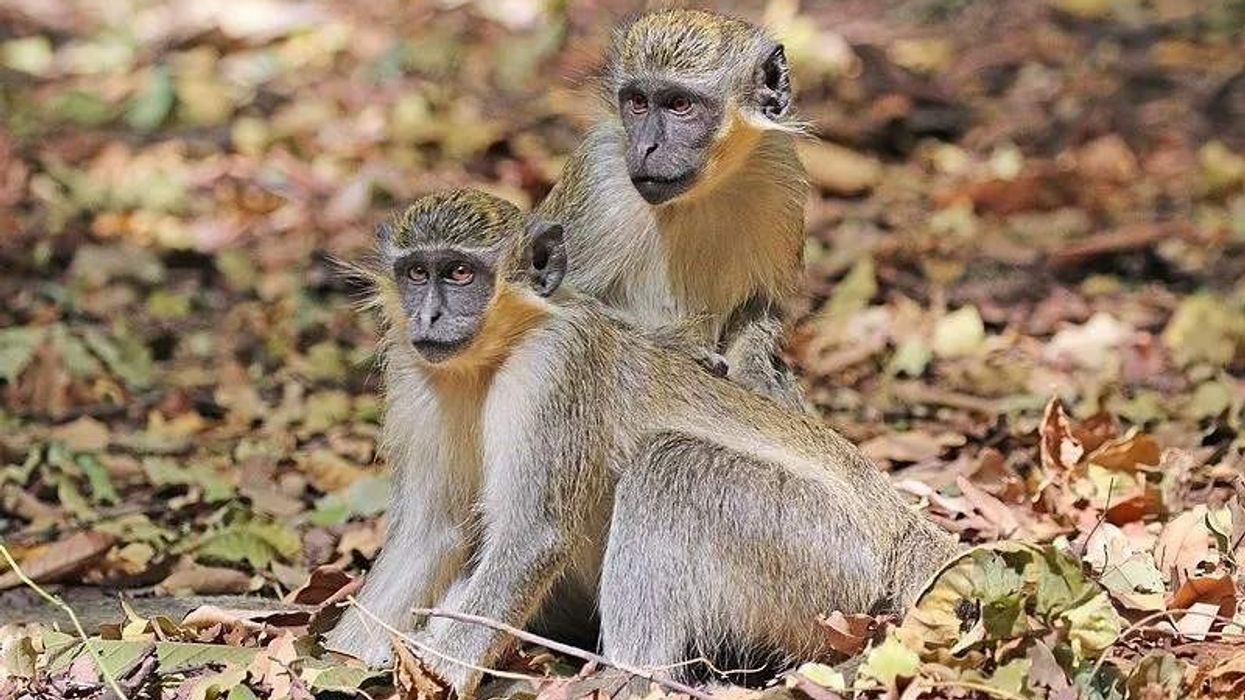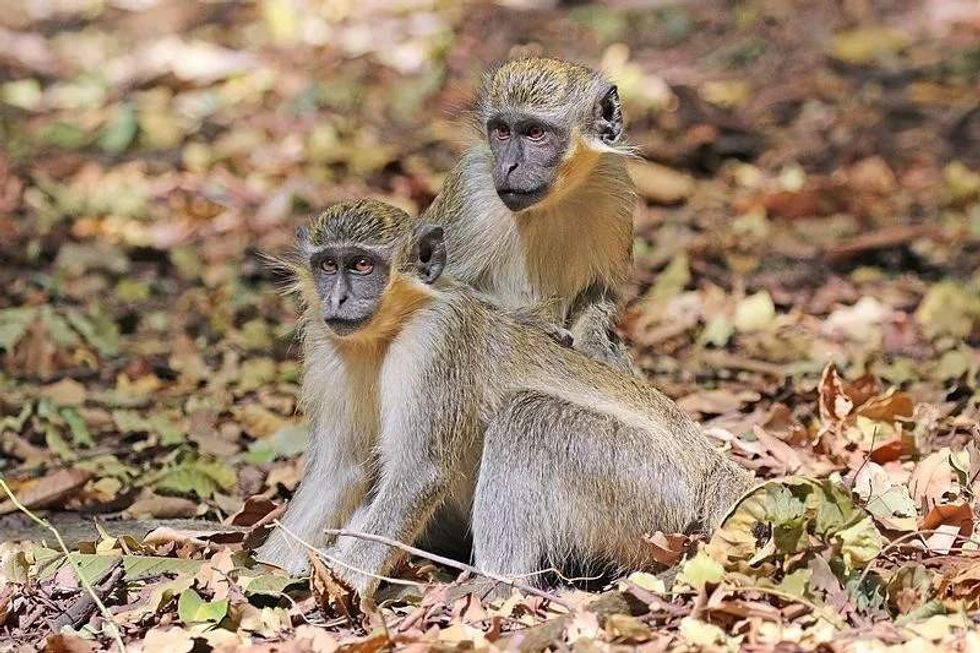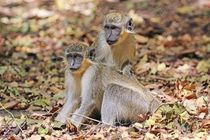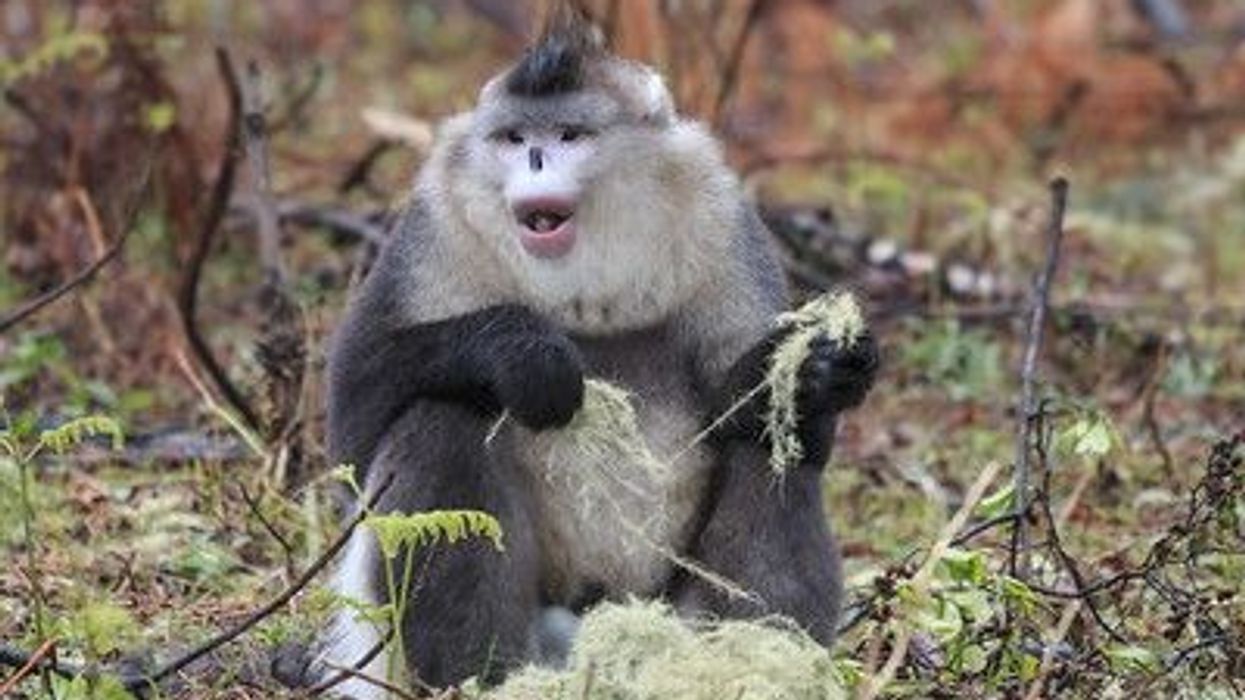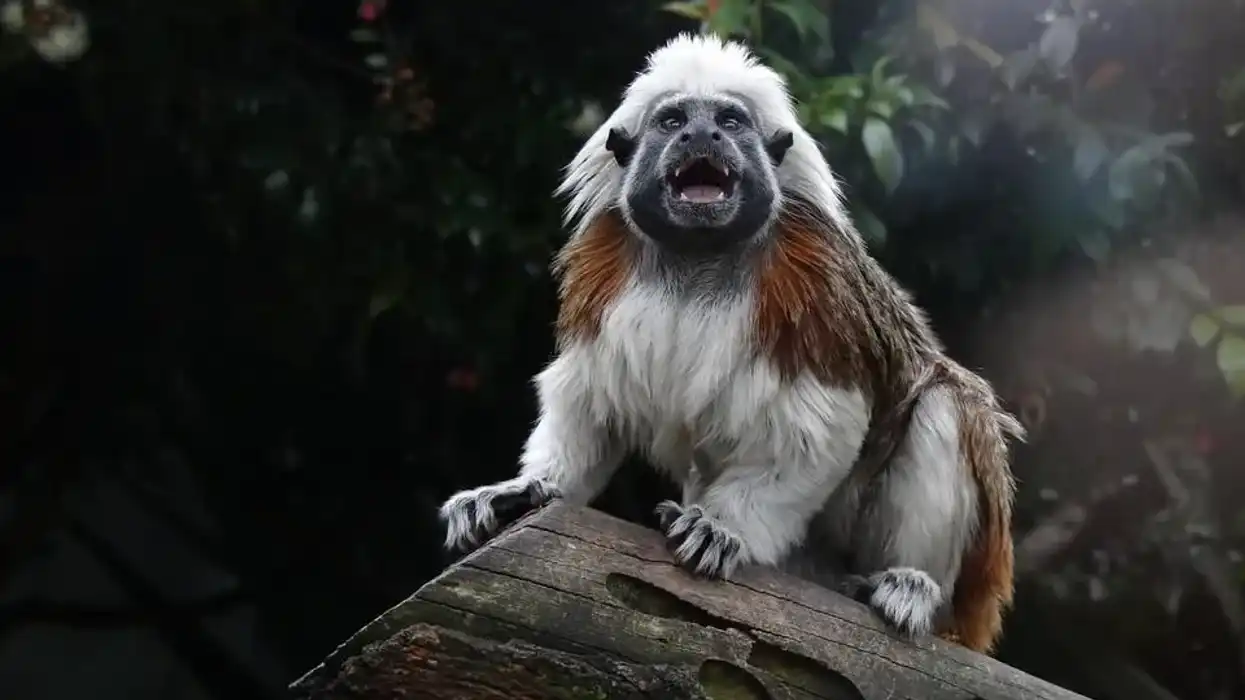Fun Green Monkey Facts For Kids

The green monkey is one of the Old World monkeys endemic to West Africa and its forest-edge woodlands. It is also found among some of the Caribbean islands of Cape Verde, Saint Kitts, Nevis, Barbados, and Saint Martin, where it was introduced during the slave trade at the latter end of the 16th century.
The green monkey species is believed to be a herbivore and frugivore feeding mainly on leaves, bananas, mangoes, papayas, roots, tubers, sap, nectar. Zoo-escaped green monkeys are also seen in Florida in the USA.
They are named green monkeys because of the green tint in their golden fur. They themselves are a heavily preyed upon species.
Being social animals, these primate monkeys may live in a group or troop of 7-80 with prominent social structures that have deciding alpha adult males. Their habitat has seen significant destruction, and despite being a species of Least Concern by the IUCN, their populations show a declining trend.
They belong to the genus Chlorocebus, and sometimes all seven members of this genus are considered to be a single species, Chlorocebus aethiops. If you like this monkey, you can also check out the patas monkey and the African wildcat.
Green Monkey Interesting Facts
What type of animal is a green monkey?
The green monkey (Chlorocebus sabaeus) is a monkey.
What class of animal does a green monkey belong to?
The green monkey (Chlorocebus sabaeus) belongs to the Mammalia class of animals.
How many green monkeys are there in the world?
The total number of green monkeys in the world is unknown.
Where does a green monkey live?
The green monkey is native to West Africa. Within West Africa or Sub-Saharan Africa.
It inhabits a range from the Ghanaian White Volta River to Senegal and Gambia. It was introduced to a range of Caribbean islands during the end of the 16th century.
The islands that have green monkey populations are the Cape Verde Islands, as well as Saint Kitts, Nevis, Barbados, and Saint Martin islands in the West Indies. A small colony of green monkeys can also be found in Florida's Broward County, which are monkeys that are descendants of the ones that escaped from zoos in the 20th century.
What is a green monkey's habitat?
In their native West Africa range, the green monkeys inhabit the forests and woody grasslands to the south of the Sahara desert and close to the Volta river. These forests and grasslands are rich in tall grasses and low bushes.
Green monkeys are also known to traverse savannahs on the south of the Sahara to get to forest edges since they do not prefer the inside of dense and moist forests. Rather uncharacteristically, the green monkey animals also live on the coasts of West Africa.
This may have been driven by deforestation and habitat destruction.
The Caribbean green monkey animals live in swamps of mangroves as well as urbanized settings and agricultural lands. Despite having preferred habitats, green monkeys have shown themselves to be highly adaptable.
Who do green monkeys live with?
Green monkeys are a highly social group of animals. These primate monkeys live in groups of 7-80 monkeys. They exhibit hierarchies borne of grooming and gender-specific behavior in their groups.
Closely related green monkeys are also known to switch groups after reaching adulthood. This aids these wild animals in avoiding predators and inbreeding, as well as maintaining a healthy gene pool. The alpha males establish territorial dominance in their habitat through displays of their scrotum and even physical altercations.
They have ranks of dominance which determines their access to resources and mates. The males even deny their female mates physical proximity to other males. Males only encroach other territories, however, if their habitat and food sources see a scarcity.
How long does a green monkey live?
The green monkey may live for 11-13 years when captive. Their lifespan in the wild may be assumed to be around the same length.
How do they reproduce?
The green monkeys reproduce by mating and giving birth to usually one infant. Because of their social hierarchies, the alpha males of a certain group dictate the social interactions between males and females.
The green monkey is a polygynous animal, meaning the males take multiple female partners. The breeding season is usually from April and June since they have heavy rainfalls, which means abundant food.
Males attain sexual maturity after five years of age, and females achieve maturity after two years. Breeding takes place about once a year usually, although the mortality rate among the green monkey infants is rather high, about 57%.
As a result, green monkeys are characteristically protective of their offspring after the gestation period up to one year of maturity. The gestation period lasts for around 165 days, after which usually one infant is born.
What is their conservation status?
The conservation status of the green monkey, according to the International Union for Conservation of Nature, is Least Concern.
Green Monkey Fun Facts
What do green monkeys look like?
Green monkeys are monkeys that are medium-sized and are named for their green-tinted golden fur. The faces of green monkeys have a hairless face dark blue bordered by a soft white fur line.
They are known to have semi-prehensile tails that are long and slender. The male has a prominent red penis and a light blue scrotum, and hence their overall appearance can be described as red, white, and blue.
The green monkeys exhibit sexual dimorphism. The males weigh 8.6-17.6 lb (3.9-8 kg), whereas the female weighs 7.5-11.7 lb (3.4-5 kg). Also, males are 1.4-2 ft (42-60 cm) in length, and females are 1-1.6 ft (30-49 cm) in length.
They have hands and feet that are pale. The tips of the tails are golden yellow.
The back parts of thighs and cheek whiskers are golden yellow as well. Green monkeys are seen mostly on all four limbs, on the ground, as well as on treetops and branches.
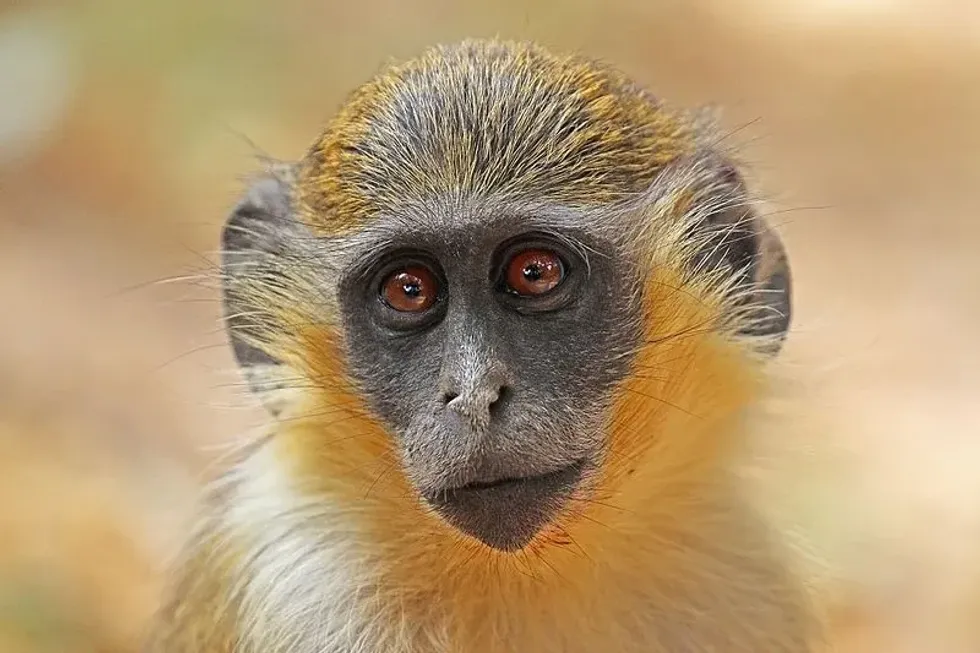
How cute are they?
Green monkeys are magnificent creatures. The only green thing about the body is the tint of their gorgeous light golden fur. They have emotive faces, using expressions just like humans to denote emotions of anger, alarm, even happiness and frustration.
They also use numerous calls and body language, most of which are for encroaching predators. Another cute thing about them is their scrotal displays of superiority, only when it doesn't devolve into fighting for territory.
Their tail tips and cheek whiskers are a beautiful golden yellow color as well. They also have pale hands and feet. They also exhibit strong maternal and paternal behavior.
How do they communicate?
Green monkeys communicate via vocalizations, body language, and facial expressions. Different vocalizations are used for different levels of dangers and threats. Some calls are even specific to certain predators.
They also use their red genitals to convey danger to other monkeys. Genitalia display also serves to form hierarchies and dominance. Green monkeys also use facial expressions to convey a range of emotions such as happiness, anger, frustration, and possibly even satisfaction and danger.
How big is a green monkey?
Green monkeys are 1-2 ft (30-60 cm) long, with the males being 1.4-2 ft (42-60 cm) long and the females being 1-1.6 ft (30-49 cm) long. On average, this makes them two to four times bigger than the pygmy marmoset and half the size of the average mandrills.
How fast can a green monkey jump?
The exact speeds of the green monkey on the ground and the treetops are difficult to pin down, but because of their semi-prehensile tails, pale feet, and nimble bodies, they can be estimated to be around 20-30 mph (32-48 kph).
How much does a green monkey weigh?
The males of the green monkey species weigh between 8.8-17.6 lb (4-8 kg), while the females weigh between 7.5-11 lb (3.4-5 kg).
What are the male and female names of the species?
The males and females of the green monkey species do not have specific names.
What would you call a baby green monkey?
A baby green monkey would be called an infant.
What do they eat?
Green monkeys are herbivores, and they eat a variety of foods such as leaves, bananas, mangoes, papayas, roots, tubers, sap, nectar. They themselves get preyed upon by leopards, humans, martial eagles, and pythons. They are known to carry cheek pouches to store food resources. Cheek pouches are common among the Old World monkeys.
How active are they?
Green monkeys are active creatures. They move between savannahs frequently to live at the edges of forests. They are active defenders of their territories.
They live and move in a group or troop while foraging for food. They've also had to become active migrators, adapting to newer habitats because of the destruction of their native habitats in West Africa. Because of being a species that is heavily preyed upon, they are actively alert to danger, using various calls for different predators.
Would they make a good pet?
No, they would not make a good pet. They are wild creatures at heart, and their populations show a declining trend. They should instead be preserved and their habitats protected. They tend to flee when captive, as evidenced by the small population in the USA's Florida that escaped from zoos.
Did you know...
The green monkey is are closely related to its Chlorocebus species mate, the vervet monkey, also sharing a similar physical description. Both these monkeys are sometimes referred to with the genus name Chlorocebus as well as with the collective name Chlorocebus aethiops.
The vervet monkey species was introduced to the same Caribbean habitats as the green monkey. The vervet monkey species, however, is native to South and East Africa.
A green monkey is not for sale. However, a thoroughbred horse who was named 'green monkey' was sold in the year 2009 for a whopping price of $16 million, a record for any thoroughbred horse. It could run a distance of an eighth of a mile in 9.8 seconds. The horse died in 2018.
Are green monkeys dangerous?
Green monkeys may be hostile and fight each other only if their territories are encroached upon by other green monkeys. They have social hierarchies and gendered roles, and encroachment of territories only happens when there is a shortage of food.
As far as humans are concerned, green monkeys do not pose a threat to them. Monkeys that live close to plantations and farms may be a nuisance by destroying crops, but they don't bother humans directly. In fact, humans are more dangerous to green monkeys.
The green monkey population has thrived in the Caribbean habitats since there aren't many natural predators but humans. They are exploitatively used for biomedical research, especially for HIV/AIDS research and testing.
Do monkeys recognize humans?
It is unclear whether monkeys can recognize specific humans. They are, however, capable of distinguishing females from males and adults from children. Research speculates that they may even identify nationalities by identifying different behavioral patterns of people. Monkeys can also, rather remarkably, learn to identify their own reflections.
Here at Kidadl, we have carefully created lots of interesting family-friendly animal facts for everyone to discover! Learn more about some other mammals from our squirrel monkey fun facts or the red kangaroo surprising facts pages.
You can occupy yourself at home by coloring in our free printable green monkey coloring pages.
We Want Your Photos!
More for You
See All
Bachelor of Science specializing in Microbiology

Oluwatosin MichaelBachelor of Science specializing in Microbiology
With a Bachelor's in Microbiology from the Federal University of Agriculture, Abeokuta, Ogun State, Oluwatosin has honed his skills as an SEO content writer, editor, and growth manager. He has written articles, conducted extensive research, and optimized content for search engines. His expertise extends to leading link-building efforts and revising onboarding strategies.
Bachelor of Arts specializing in English Literature, Masters of Art specializing in English and Communication Skills

Sonali RawatBachelor of Arts specializing in English Literature, Masters of Art specializing in English and Communication Skills
Sonali has a Bachelor's degree in English literature from Guru Gobind Singh Indraprastha University and is currently pursuing a Master's in English and Communication from Christ University. With considerable experience in writing about lifestyle topics, including travel and health, she has a passion for Japanese culture, especially fashion, and anime, and has written on the subject before. Sonali has event managed a creative-writing festival and coordinated a student magazine at her university. Her favorite authors are Toni Morrison and Anita Desai.
Disclaimer
1) Kidadl is independent and to make our service free to you the reader we are supported by advertising. We hope you love our recommendations for products and services! What we suggest is selected independently by the Kidadl team. If you purchase using the Buy Now button we may earn a small commission. This does not influence our choices. Prices are correct and items are available at the time the article was published but we cannot guarantee that on the time of reading. Please note that Kidadl is a participant in the Amazon Services LLC Associates Program, an affiliate advertising program designed to provide a means for sites to earn advertising fees by advertising and linking to Amazon. We also link to other websites, but are not responsible for their content.
2) At Kidadl, we strive to recommend the very best activities and events. We will always aim to give you accurate information at the date of publication - however, information does change, so it’s important you do your own research, double-check and make the decision that is right for your family. We recognise that not all activities and ideas are appropriate for all children and families or in all circumstances. Our recommended activities are based on age but these are a guide. We recommend that these ideas are used as inspiration, that ideas are undertaken with appropriate adult supervision, and that each adult uses their own discretion and knowledge of their children to consider the safety and suitability. Kidadl cannot accept liability for the execution of these ideas, and parental supervision is advised at all times, as safety is paramount. Anyone using the information provided by Kidadl does so at their own risk and we can not accept liability if things go wrong.
3) Because we are an educational resource, we have quotes and facts about a range of historical and modern figures. We do not endorse the actions of or rhetoric of all the people included in these collections, but we think they are important for growing minds to learn about under the guidance of parents or guardians.
